How to keep troublemakers from ruining your Zoom meetings
Glenn Fleishman is the author of Take Control of Zoom, a new 140-page ebook that offers exhaustive details on using Zoom effectively as a meeting participant and as a host, who starts and manages meetings. This article is an adapted excerpt from the book.
The Zoom videoconferencing service makes it easy to to create meetings anyone can join from your company, family, school, PTA, or soccer club. It’s just as simple to set up public meetings, in which acquaintances or strangers gather to hear a presentation, comment on a public proceeding, or offer each support for an alcohol or chemical dependency.
Zoom is packed with features for “hosts,” the service’s name for those who start and manage meetings. Hosts can wrangle participants before and during a videoconferencing session. The tools for setting up a meeting are nearly as important as moderation before and during an event.
Meetings among peers, friends, and coworkers require less control than ones involving people you don’t know well. But once you venture out from that safety zone, it’s a good idea to batten down the Zoom hatches. Any time people who have to manage themselves in a meeting join, you may have to step in to help. That includes students, who may not recognize the repercussions of acting out online among classmates, when a teacher can see and hear everything they do.
Start with safe settings
You can create baseline meeting characteristics at the Zoom website. In the Meeting Settings section, you make choices that affect controls within meetings, only some of which can be changed after a meeting starts. I recommend setting meetings to start with video on, participants muted on entry, screen sharing disabled except for the host, and participants required to cool their heels in the Waiting Room, a sort of virtual antechamber you control as host. Make sure that “Join before host” is disabled while “Waiting room” is turned on.
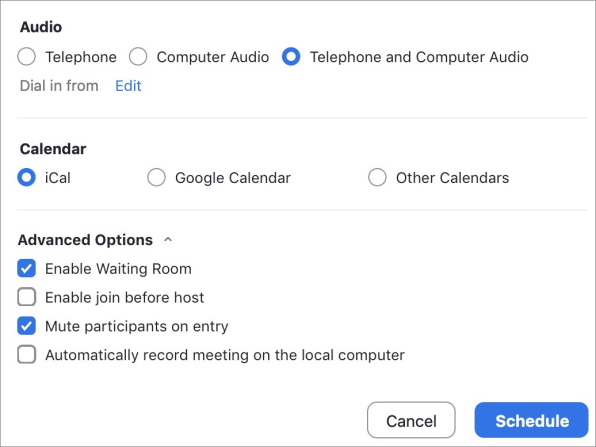
You might also consider disabling two chat features. One chat setting lets you prevent people from privately messaging each other. This can reduce the potential for harassment. The other disables folks from messaging the group.
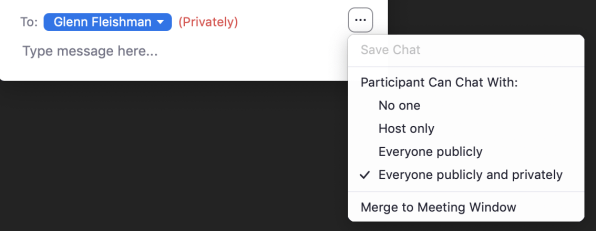
For additional safety, disable the ability of removed participants to rejoin. If you boot someone, having this setting turned off means they can’t reenter the Waiting Room or join a meeting. Disable participants’ ability to rename themselves, too: while this might seem like a benign feature, students in particular will make use of it to post booger jokes (and worse) while a class is underway.
Zoom’s use of virtual backgrounds that cut you out in the foreground and let you put a bucolic scene or a shot of stars (or a magazine cover) behind you is a great advantage for those working from home, who may have chaos around them from family members. However, you may want to disable virtual backgrounds by participants, because someone may join with an anodyne backdrop, and then change it to something disruptive or hateful during a meeting.
Finally, I recommend disabling people’s ability to make a local recording of a Zoom session. While attendees can still use the screen-recording options built into operating systems to capture a meeting, Zoom’s built-in feature makes it a bit too easy for people to share video of a session. With this option disabled, you can still make a recording as a host, and a participant can request to record and be granted permission if there’s a reason for it.
Prepare to start a meeting safely
With the above settings, no one can join an active meeting and interact before two or three steps take place. First, you have to start the meeting. In Zoom’s desktop apps, for a scheduled meeting, click the Meetings button, select the meeting, and click Start. To start a meeting instantly, without prearrangement, click the Home button and click New Meeting.
In a Zoom mobile app, start a scheduled meeting by tapping the Meetings icon and then tapping Start to the right of the intended meeting. You can start an instant meeting by tapping Meet & Chat and then tapping New Meeting. A view appears that lets you select whether or not your video starts immediately, picking up your default preference. Tap Start a Meeting.
When you start the meeting—assuming you’ve taken my advice and enabled the Waiting Room—you see anyone waiting to join in the Participants list. Click the Participants button in a desktop app or tap the Participants icon in a mobile app to view this list. While participants wait, they see a message that explains the host will “let you in soon.” As a host, as people enter the Waiting Room, you see a pop-up or overlay that notes someone has joined. You have the option to choose Remove or Admit. It disappears after a short interval. (Without Waiting Room turned on, as soon as you start the meeting, everyone is immediately placed into a videoconference.)
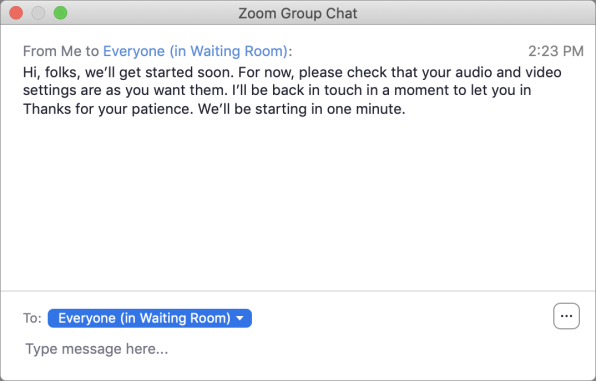
When viewing the Participants list, the people in the Waiting Room not yet admitted to the meeting have labels next to their names. This is a great time to review the names—as Zoom shows them—of everyone who wants to join. You can use chat to message everyone in the Waiting Room or specific individuals.
If you need to know the name of each participant, this is a good time to check to see who you don’t recognize by name or handle. If you can’t identify participants in the Waiting Room, you can ask them to change their name or—if you disabled name changing—you can click the More button and choose Rename to do it for them.
In the desktop app, you see Remove and Admit buttons; in mobile apps, there’s just an Admit button, but you can swipe left to reveal Remove. Choosing Admit allows people into the meeting with whatever settings you’ve allotted participants. Choosing Remove prevents them from joining. With multiple people waiting, you can tap or click Admit All—only good if you’re sure you want all those folks to get in.
As you admit people to the meeting, they can start unmuting themselves or start streaming their video, depending on your account settings or a few options you choose when creating a scheduled meeting.
Manage people in a meeting
When the meeting starts, it’s often a good idea to present a short introduction, which could include the rules under which you’re running the meeting, and, for public meetings, expectations of behavior. You can explain how you will mediate conflicts with the rules or among people, like, “If people start speaking over each other, I will disable chat and mute everyone’s audio, then select who is next to speak and unmute them during their turn.”
Depending on how people are behaving or how you want to run the meeting, you may want to make use of the following approaches, most of which require using the Participants list. In desktop apps, hover over a person’s name in the Participants list and click the More button to get more options. In Zoom’s mobile apps, view the Participants list and tap someone’s entry to see available choices.
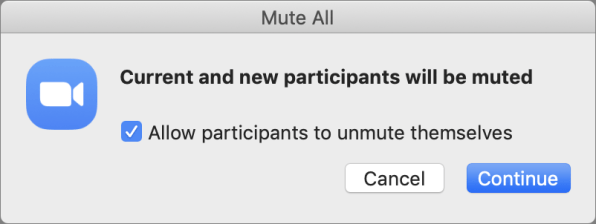
Escalate meeting controls for sanity and safety
The tools above may work in many kinds of meetings, but not all—particularly ones with people may try to join to disrupt the meeting through offensive or abusive behavior (so-called “zoombombing”), or in which adults act like children or children act like children and need more authority placed over them to keep the meeting on track.
Zoom added a one-stop spot in March 2020 to its desktop apps for managing several safety-related features, one reason I advise hosting all meetings from a desktop Zoom app. Click the Security button and you can toggle Lock Meeting and Enable Waiting Room. The Waiting Room, as explained above, prevents anyone from joining without your permission. However, Lock Meeting bars anyone from even entering the Waiting Room.
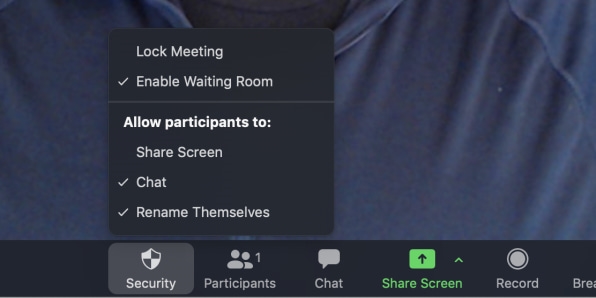
The Waiting Room is very useful, and you can vary how you deploy it. For some meetings, you might let people join without waiting, and once everyone you expect has arrived or you reach a given cutoff time, you enable the Waiting Room to prevent additional people from joining without screening. You might also use Lock Meeting, which prevents anyone from even joining the Waiting Room. You can provide an out-of-band method—like giving people your email, cell number, or WhatsApp handle for use if someone arrives late and finds the meeting locked.
One of the most common zoombombing scenarios I’ve heard involves meetings that are underway. After a few minutes, or longer, they’re blitzed by trolls who have found the URL. The Waiting Room provides a strong defense, but if 100 people crowd into that queue, ushering in the right people is still a cognitive load on you as a host when you’re probably trying to manage other parts of a meeting.
Use the Remove button in the Waiting Room liberally for public meetings in which you recognize an unwanted party or you believe someone is using an intentionally problematic profile name or picture.
(Some meetings may operate under government laws or nonprofit or corporate bylaws, and restrict whether participants can be removed. However, it’s almost always the case that discretion can be used. Just like someone wearing racist imagery on a t-shirt or shouting obscenities might not be allowed into a public meeting, someone engaging in that behavior through a profile name or picture may be excluded on that basis. Check with a meeting chair, legal counsel, or other authorities for how this applies to your meetings.)
The Security button and mobile Security settings also let you toggle access to screen sharing and chat, and control whether participants may rename themselves during a meeting. As noted above, you can set these preferences in your Zoom account ahead of time, and then change them mid-meeting as needed.
Even in a well-controlled setting, you may not want to let participants use text chat during the whole meeting in order to avoid distractions, particularly among K–12 students. Likewise, you may not want kids in that range to be able to change their name from “Robert S. Selbstbach” to “Booger McFartpants” while a session is underway.
Screen sharing is trickier, as you might want to let a participant share an image, presentation, video, or other item during a meeting. Zoom doesn’t have a granular control to let you give control only to certain people.
The most sensible way to make this work is to chat privately with a person you want to present, enable screen sharing for participants via the Security button, have that person start, and then disable the control. Because they’re already underway at that time, they can continue.
Toss folks out
If people who join the meeting prove unmanageable, you have a series of escalating options on how to respond.
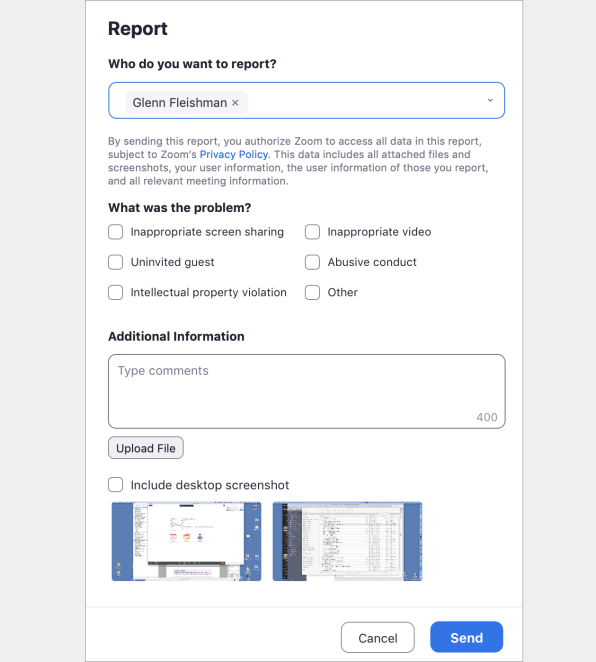
Of course, as long as Zoom allows non-logged-in participants to join and free signups with any email address, reporting trolls is a bit of a whack-a-mole problem. However, combined with other tools above, it’s a way to deter and wear them down. They’ll be less and less able to carry out any abuse in Zoom, making it less rewarding to keep trying.
(24)



